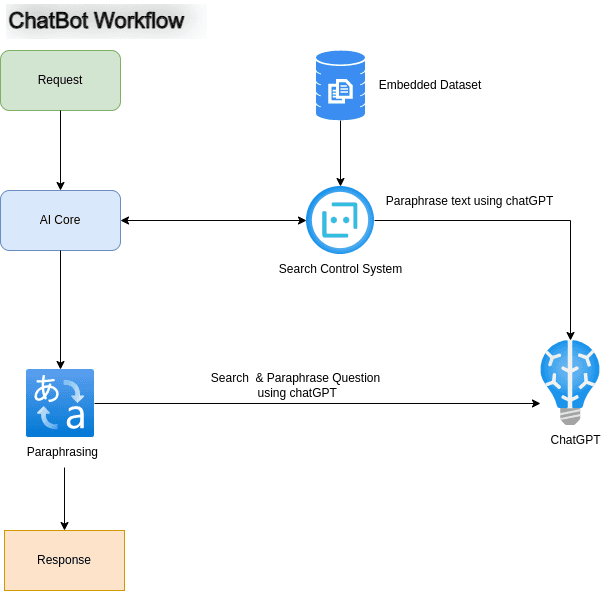ChatGPT training for your AI chat widget

Understanding the Importance of ChatGPT Training
Training your AI chatbot with ChatGPT is vital for several reasons. Firstly, it enables your chatbot to generate more accurate and contextually appropriate responses, enhancing the overall user experience. Secondly, ChatGPT training ensures your chatbot can adapt and learn from new data, staying up-to-date and relevant to users. Moreover, proper training equips your chatbot to understand complex queries and provide relevant information, making it a valuable asset across various industries. For example, an e-commerce company can use chatbot analytics to identify trending products and customer preferences, guiding inventory and marketing strategies. If you provide financial services, analyzing chatbot conversations to uncover common customer pain points can lead to product and service improvements.
AI chatbots undergo a crucial development step with training. Without it, chatbots may struggle to understand user queries and provide meaningful responses. ChatGPT, a state-of-the-art language model by OpenAI, serves as an effective solution for training chatbots, improving their performance.
Another significant advantage of ChatGPT training is its ability to equip your chat widget with the skills to understand complex queries. Traditional chatbots often struggle with nuanced or multifaceted questions, resulting in inaccurate or irrelevant responses. Training your chatbot with ChatGPT empowers it to comprehend and dissect complex queries, providing more precise and relevant information. This capability makes ChatGPT-trained chatbots valuable assets in industries such as healthcare, finance, and e-commerce, where complex queries are common.
Furthermore, ChatGPT training ensures that your chatbot stays up-to-date and relevant to users. As new data becomes available or user preferences change, adapting to these updates is essential. The training process allows your chatbot to continuously improve its performance, incorporating new information and adapting its responses. This adaptability ensures your chat widget remains effective and provides accurate information as user needs evolve.
How to Train Your Chat Widget using ChatGPT

Before delving into how to train your chat widget, take a look at the above flowchart which shows how a user request to chatbot is processed.
Training your chat widget with ChatGPT or a similar large language model involves several steps to ensure the chatbot understands and responds accurately to user queries.
With our step-by-step guide, to provide a more comprehensive understanding of Best Practices for Training Your AI Chatbot, consider a hypothetical scenario in which Dr. Smith successfully deployed an AI chat widget for patient care, and meticulously trained it, achieving optimal outcomes.
Step 1: Define Objectives and Use Cases
Identify Goals: Clearly define what you want to achieve by integrating ChatGPT model into your chat widget, such as improving customer service, handling FAQs, or providing personalized recommendations.
Outline Use Cases: Determine specific scenarios and use cases where ChatGPT can enhance the chat widget's functionality.
Dr. Smith aims to integrate a ChatGPT model into his clinic's chat widget to enhance customer service, efficiently handle FAQs, and provide personalized health advice. The use cases include appointment scheduling, providing clinic information, and offering general health guidance.
Appointment Scheduling: Patients can schedule, reschedule, or cancel appointments without human intervention, aiming to reduce the clinic's administrative workload by 30%.
Providing Clinic Information: Offering instant responses to common queries about clinic hours, services offered, and insurance policies, aiming to decrease phone inquiries by 50%.
Offering General Health Guidance: Supplying basic health information and advice while directing more complex issues to human specialists, aiming to increase patient engagement by 40%.
Step 2: Gather and Prepare Training Data
Collect Conversations: Compile existing customer service conversations, FAQs, and other relevant dialogues that represent typical interactions users might have with your chat widget.
Data Cleaning: Clean the data to remove sensitive information, errors, and irrelevant content, ensuring the training data is high-quality and relevant.
The clinic compiled past patient interactions and frequently asked questions to represent typical inquiries. The data was cleaned of any sensitive information to ensure privacy and relevance. The clinic compiled 5,000 past patient interactions and 200 frequently asked questions to represent typical inquiries. After cleaning, the dataset was reduced to 4,500 interactions, ensuring privacy and relevance while maintaining a comprehensive range of topics.
Step 3: Choose the Right Model and Tools
Select a ChatGPT Version: Choose an appropriate version of ChatGPT or a similar model that suits your needs, considering factors like language capabilities, domain specificity, and computational requirements.
Integration Tools: Select tools and platforms that support integration with ChatGPT and your chat widget, ensuring compatibility and ease of use.
Dr. Smith chose a version of ChatGPT that supported multiple languages and medical terminology. He selected integration tools that were compatible with the clinic's existing chat widget. Dr. Smith selected ChatGPT-4 for its advanced language capabilities, including understanding medical terminology. Integration tools compatible with the clinic's existing chat widget and electronic health record (EHR) system were chosen to ensure seamless operation.
Step 4: Customize and Fine-Tune the Model
Initial Customization: Use the prepared training data to customize ChatGPT's responses, aligning them with your brand voice and specific use cases.
Fine-Tuning: If your platform allows, fine-tune the model with your training data to improve its understanding and responses to domain-specific queries.
The ChatGPT model was initially customized using the clinic's data, ensuring the chatbot responses were in line with Dr. Smith's brand voice and medical advice standards. Fine-tuning was conducted with the aim to handle medical-specific inquiries accurately. Fine-tuning aimed to achieve 90% accuracy in handling medical-specific inquiries.
Step 5: Integrate ChatGPT with Your Chat Widget
API Integration: Connect your chat widget to ChatGPT using the model's API, ensuring secure and efficient communication between the chat widget and the model.
Set Up Response Handling: Implement logic in your chat widget to handle responses from ChatGPT, including formatting, filtering, and fallback strategies for unanswered queries.
Dr. Smith's team connected the chat widget to ChatGPT using the provided API, set up response handling mechanisms, and ensured fallback strategies for complex medical questions that required human intervention. This setup aimed to handle up to 1,000 daily patient interactions.
Step 6: Test and Validate
Internal Testing: Conduct thorough testing with a range of queries to evaluate ChatGPT's performance in the chat widget, paying attention to accuracy, relevance, and consistency of responses.
User Testing: Optionally, conduct beta testing with a limited user group to gather feedback on the chat widget's performance and identify areas for improvement.
The chat widget underwent rigorous internal testing to ensure ChatGPT's responses were accurate and relevant. A beta testing phase followed, where select patients provided feedback on the widget's performance. The chat widget tested with a database of 500 simulated patient queries to ensure ChatGPT's responses were accurate and relevant. A beta testing phase with 100 real patients provided feedback, resulting in an 85% satisfaction rate.
Step 7: Monitor and Iterate
Performance Monitoring: After deployment, continuously monitor the chat widget's interactions, focusing on user satisfaction, response accuracy, and any technical issues.
Iterative Improvement: Use insights from monitoring and user feedback to make iterative improvements to the chat widget, including adjusting ChatGPT's integration and response handling.
Post-deployment, the clinic continually monitored the chat widget to assess user satisfaction and response accuracy. Insights gained from user interactions were used for iterative improvements to the chat widget and ChatGPT integration. The clinic monitored the chat widget, focusing on metrics such as user satisfaction (targeting an 85% satisfaction rate), response accuracy (aiming for 90% accuracy), and technical issues (with a goal of less than 5% unresolved queries). Insights from user interactions led to monthly updates to improve the chat widget and ChatGPT integration.
Step 8: Ensure Ethical and Compliant Use
Data Privacy: Make sure your chat widget's use of ChatGPT complies with relevant data protection regulations, ensuring user data is handled securely and ethically.
Content Moderation: Implement mechanisms to monitor and moderate the chat widget's content, preventing inappropriate or harmful responses.
Dr. Smith made certain that all chatbot interactions were compliant with health data protection regulations like GDPR or CCPA. A content moderation system was also implemented to prevent any inappropriate or harmful responses. A content moderation system was implemented to review and prevent any inappropriate or harmful responses, with a less than 1% error rate in content moderation.
Results: By following best practices for AI chatbot implementation and management, Dr. Smith's clinic enhanced patient support and operational efficiency. The chatbot became an integral part of their healthcare provision, embodying the clinic's commitment to accessibility, patient education, and continuous improvement. Through regular updates and retraining, the chatbot remained a relevant and reliable resource, reflecting the evolving needs and expectations of their patient community. This initiative not only bolstered patient satisfaction but also positioned Dr. Smith's clinic as a forward-thinking practice in leveraging AI to enhance healthcare services.
Training and integrating ChatGPT with your chat widget requires careful planning, customization, and ongoing management to ensure the chatbot meets user needs and aligns with your business objectives.
Alternatives to training with ChatGPT - LLaMA 2
LLaMA 2 is Meta's latest entry into the world of AI-powered large language models (LLMs), positioned as an open-source alternative to other prominent LLMs like OpenAI's GPT and Google's Bard. It's designed to be freely available for both research and commercial use, making it a significant release for the AI community.
The development and release of LLaMA 2 include a range of pretrained and fine-tuned models, with parameters ranging from 7 billion to 70 billion. These models, particularly fine-tuned ones called Llama 2-Chat, are optimized for conversational AI, indicating Meta's focus on creating highly capable dialogue systems. These models reportedly outperform other open-source chat models on various benchmarks and are considered suitable substitutes for closed-source models, according to Meta's own evaluations for helpfulness and safety.
One of the most compelling aspects of LLaMA 2 is its commitment to responsible AI development. Meta has launched a Responsible Use Guide and engaged in safety red-teaming to identify and mitigate potentially problematic responses, underscoring its commitment to safety and performance in AI applications.
However, it's important to note that LLaMA 2, like all large language models, has its limitations. Meta has not disclosed the exact data set used for training, raising questions about potential copyright or privacy issues. The model shares the common LLM challenges of producing inaccurate or offensive content, despite efforts to improve its safety and reliability.
For those interested in exploring LLaMA 2's capabilities, it doesn't have an easy-to-use demo like some of its competitors. However, it's accessible through platforms like Hugging Face, where various versions optimized for chat (Llama 2 Chat) can be tested. These versions come in different sizes, from 7 billion to 70 billion parameters, catering to different performance and speed requirements.
This development represents a significant move by Meta to provide an open, accessible foundation for AI innovation, allowing developers, researchers, and businesses to experiment and innovate with fewer restrictions than some proprietary models. It highlights a growing trend towards more open AI research and development ecosystems, potentially democratizing access to cutting-edge AI technologies.
Best Practices for Training Your AI Chatbot
Follow best practices to ensure optimal results when training your AI chatbot with ChatGPT. Thoroughly preprocess training data, removing sensitive or personally identifiable information. Consider data augmentation techniques to increase dataset diversity, exposing your chatbot to a wider range of user interactions. A survey by IBM found that 81% of respondents are more concerned about the privacy of their data now than they were a few years ago, underlining the importance of removing sensitive information from training datasets
Regularly update and retrain your chatbot to maintain performance. User inquiries and expectations evolve, and a stagnant chatbot becomes less effective. Periodic retraining ensures your chatbot remains up-to-date, providing valuable assistance to users. Salesforce research indicates that 51% of consumers expect companies to anticipate their needs and make relevant suggestions before contact, highlighting the need for AI systems to be continually updated and retrained to meet evolving customer expectations.
Training AI chatbots with ChatGPT presents challenges. Avoid biases in training data to prevent biased or unfair responses. Carefully review and curate training data to mitigate biases. Address the challenge of generating plausible but incorrect responses, known as "hallucinations," by monitoring and fine-tuning the model during training.
After ChatGPT training, evaluate your chatbot's performance. Assess metrics like response relevance, coherence, and user satisfaction. Conduct user tests and solicit feedback to identify strengths and weaknesses. Based on this evaluation, refine your chatbot's training process for further improvement.
Future Trends and Innovations

By the year 2027, it is forecasted that the global chatbot market will reach a valuation of 455 million USD. This significant growth is expected to be propelled by the incorporation of Artificial Intelligence and Machine Learning technologies, highlighting their crucial contribution to the market's developmental path.
As technology advances, the field of training AI chatbots with ChatGPT evolves. Innovative techniques aim to improve training efficiency and performance. One trend is the integration of multimodal inputs, allowing chatbots to process responses based on both text and visual cues. Ongoing research addresses challenges such as bias mitigation and fine-tuning to enhance the social impact and reliability of AI chatbots.
In conclusion, ChatGPT training is a critical step in turning your AI chatbot into an intelligent and capable conversational agent. Follow best practices, choose the right data, and implement effective techniques to optimize the performance of your chatbot. Continuous evaluation and adaptation are essential to ensure your chatbot stays relevant in an ever-changing landscape. Embrace the potential of ChatGPT training and unlock a world of possibilities for your AI chatbot.
Interested in building your AI chatbot?
On February 27th, Sendbird launched a no-code AI chatbot, powered by OpenAI's advanced GPT technology, is ready to deploy on your website in minutes. This sleek, multilingual AI chatbot solution is designed for businesses seeking to enhance customer service, boost lead generation, and increase sales, all while streamlining operations. This custom GPT solution goes beyond answering queries; it creates connections and builds the foundation of business relationships, making every customer feel valued and understood.
Sign up for your free trial at: https://sendbird.com/ai-chatbot-free-trial










